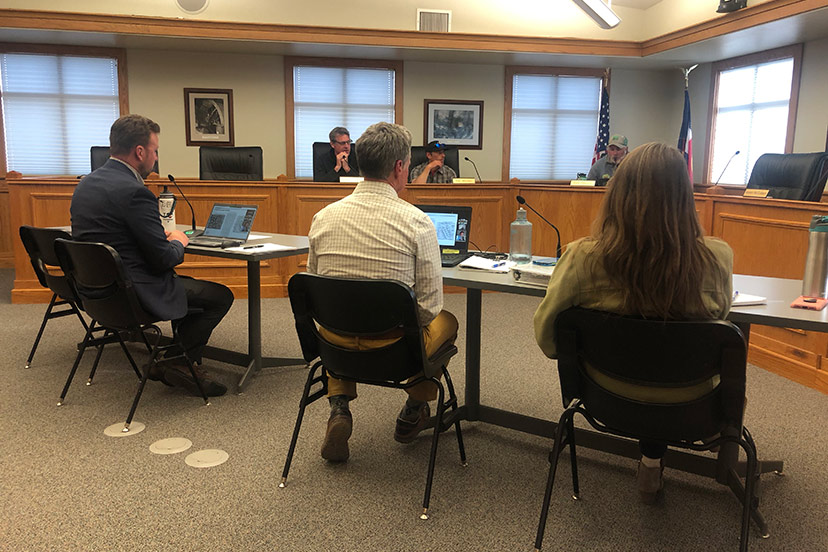In Part One, we discussed briefly the presentation by Town of Pagosa Springs Senior Planner Karl Onsager to a joint meeting of the Town Council and the Town Planning Commission, on April 27, concerning the requirements in the existing Land Use and Development Code (LUDC) and how those requirements might change in a pending LUDC update.
You can download the 29-page PDF of his presentation here. (4MB file)
Mr. Onsager was discussing the way the Town government controls signage, and Planning Commissioner Mark Weiler had raised questions about the negative financial impacts of the Town’s signage requirements on struggling Pagosa businesses, most of which are located within the town boundaries. Mr. Weiler’s questions were not specifically answered, as I recall.
There are financial impacts to government control of private property uses. Some of the regulations impact the property owner’s wallet, sometimes severely.
Other impacts land on the government itself, in terms of staff salaries. I recall, back in about 2010, during the depths of the Great Recession here in Pagosa Springs, when the local construction industry had come practically to a standstill. At that time, the Town Building and Planning Department consisted of just two employees. As I recall.
Currently, the Planning Department — which now goes by the name of ‘Community Development Department’ — consists of eight people, almost all of whom spend a significant portion of their time enforcing rules that impact the cost of development.
The regulations have other impacts as well. Social impacts, for example.
In addition to asking the joint board members their opinions about signage rules, Mr. Onsager also asked for comments on five other issues.
Whether to re-write the LUDC — or not — with an aim to increase in available housing types.
Whether to add a new set of ‘sustainability’ requirements that must be met by new development (and by existing development, eventually?)
Clarifications to what constitutes a major subdivision requiring a public hearing process.
Creation of the new East End Overlay District and Put Hill Overlay District.
Necessary (or desired?) level of public engagement prior to public hearings for the update adoption.
That last item — “public engagement” — some people might find interesting.
Here’s a summary from the presentation PDF.

The Town did a few public presentations early on in the LUDEC update process, and also appointed a special task force to oversee the progress and contribute a ‘local’ perspective that might not be otherwise obvious to the consultants from Fort Collins — Logan Simpson — who were hired to handle the grunt work. But as far as I know, the LUDC update has been collecting dust for the past year, and the public discussion of the 200-page document has been non-existent.
Even the special LUDC steering committee has become inactive.
Here’s a comment from Town Council member Gary Williams, who served on the steering committee prior to being appointed to a vacant seat on the Council.
“Two of our Council members ascended to our lofty positions by starting with LUDC code steering committee. And when we started, the composition of the group represented certain groups in town. That was very important. We had Brad Ash representing, you know, architects and builders…and [engineer] Mike Davis… and so I just want to ask. What groups are represented on the LUDC committee now? And what groups were left off?”
Community Development Director James Dickhoff:
“Well, we still have the same members. We haven’t had a steering committee meeting for quite a while… Our intent is to provide an update to the committee, so they’re staying abreast… so we have the same representation on the steering committee as we have in the past.”
Williams:
“Okay. So do we have any builders represented?… Bob Hart was the member originally [representing the construction industry] and he’s not there any more. So I was just wondering…”
Dickhoff:
“Yeah. We do not have the builders represented, currently, since Bob has left.”
(Mr. Hart no longer lives in Pagosa Springs.)
“But again, like I said, we haven’t had a steering committee meeting in quite a while. Probably a good year. So…”
Williams:
“Well, the reason I brought it up was, not everyone in town is interested in this, you know. Unless you’re trying to build something, or the new development is going to be next door, you don’t really care. So anyway… I think the focus group approach might be a smarter approach, to find out what the key constituents in town think about [the proposed changes.]”
As we note in the PDF summary above, ‘focus groups’ are one suggested strategy for getting the public involved in the LUDC update. I would define the ‘LUDC steering committee’ as a focus group, but one which has been inactive for “probably a good year.”
Another strategy is “surveys”.
I discussed “surveys” in a recent editorial, here in the Daily Post, and noted that surveys are sometimes grossly inaccurate, in terms of reflecting the true opinions in the community.
“Invitations for staff office-hours” is an interesting suggestion, although I have no idea what it might mean.
Tomorrow, I’d like to discuss the idea of community involvement in a bit more depth.
The Town government extracts millions of dollars a year from our pockets, through sales taxes. How to spend that money?
How much of it should be spent creating regulations that then end up costing us even more money, when we want to develop our property?
How much of it should be spent informing the community about pending legislation, and how much should be spent listening to the community’s ideas?
Read Part Four…

